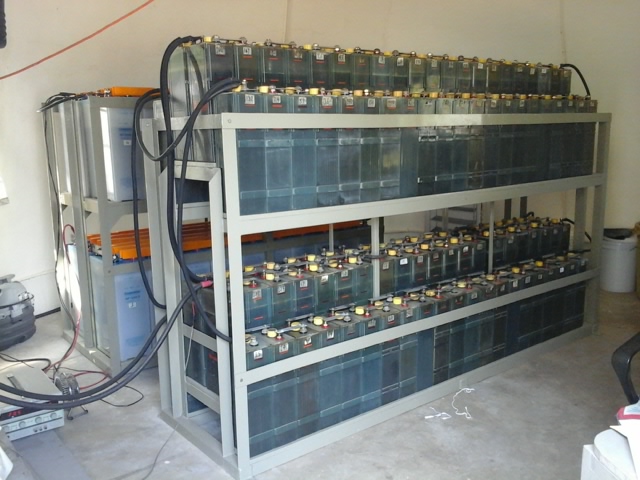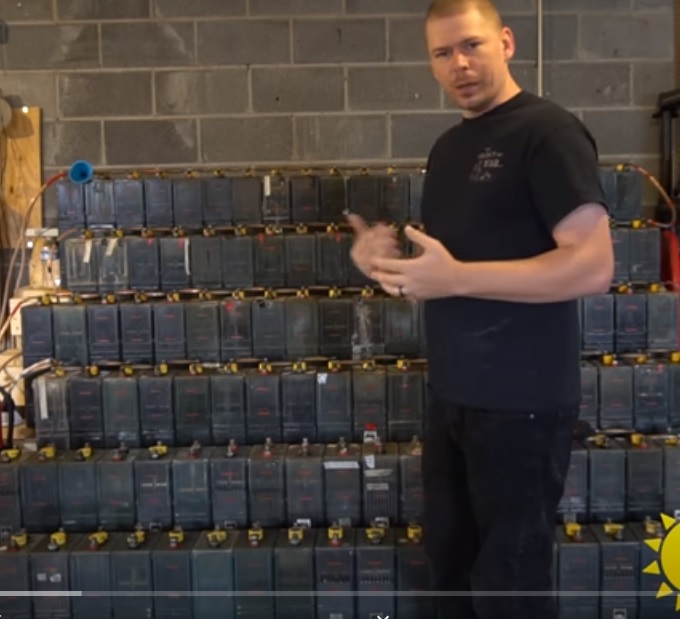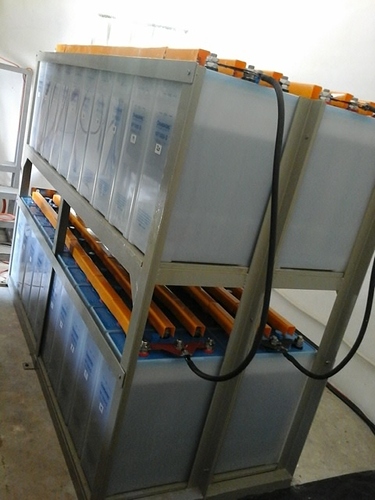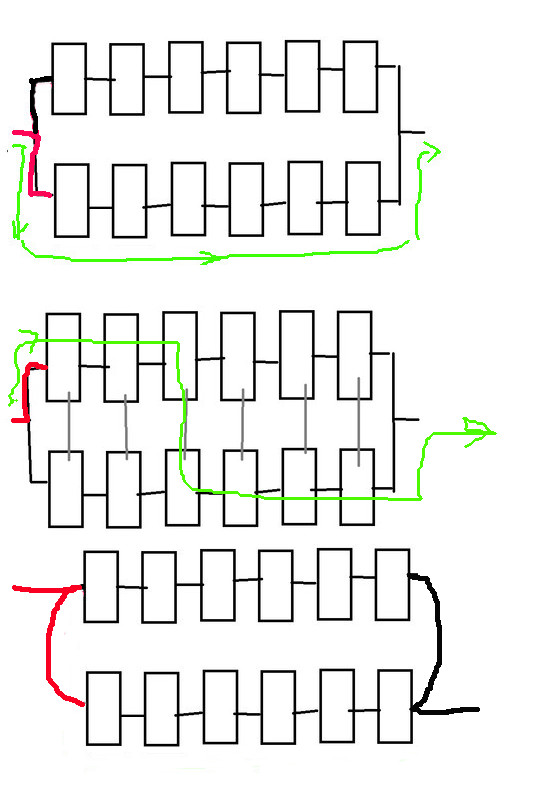Dan, please don’t miss-understand me. I agree with you 100%. Application, Availability, Cost, Weight, Ease of use, Safety. Each might or might not be important to the particular job at hand. I still like Lead/Acid batteries, too, and if I could get some Edison Iron-Nickel batteries to play with… I will sometime!  (saw some at the metal re-cyclers a couple weeks ago).
(saw some at the metal re-cyclers a couple weeks ago).
Just make sure the Edsion batteries are not nickel Cadmium those are hazardous materials in the USA and where very common in the 70s and 80s I think early remote radio towers or cell phone towers. There is a ton of talk about them online that they where dumped by industry to avoid the cleanup costs. I don’t know the Edison batteries well enough to known which ones are which.
I am a fan of the newer lead acid batteries that use carbon wrapped negative plates to avoid sulfur buildup on the plates. They have a 12 year rating which is impressive for lead acid.
Al from a quick Google search it looks like you can choose 12, 24, 36 or 48 volts with that controller
Wow, quite a knowledge. Can you name a brand for that new lead acid?
Lipo is quite good for staionairy? Less fire hazard? A little more weight but longer lasting?
https://www.northstarbattery.com/blue-plus-battery
I bought some for a system here but haven’t gotten to installing it yet. Once I get going on the install I will start a thread about the system.
Hi Mike , i hope you snapped up those cells , would be my wish if ever i came across them for sure .
I have just bought 16 lifepo4 used cells from someone shipping new and used cells into Australia from the USA ,with 90 /95% life left in them for less than half price of the cost of new cells , these 100ah sinopoly cells came out of a bus i am told cant wait to play with them , you are so lucky over there in the states i have seen many used power wall type battery packs for a fraction of the price we pay here
The cells I saw had single yellow plastic caps that said “Edison” on them. they were about 2 inches by 5 inches and about a foot tall. Looked like pullouts from a telephone company or railroad signal system. I wanted to ask, but the timing was all wrong. I am truly grid-locked with junk anyhow, and in need to develop a “Getting rid of” skill set vs. the acquisition skill set I have lived by so far. Might have been the Nickel-Cadmium version as Dan said, they looked like these the video claims are nicad.
Mike the only Edison Nickel iron I have ever seem are really old in metal cases. I honestly don’t know how long the Edsion company made the nickle iron. But if I ever found some of the old ones I would definitely try to bring them back to life. I have read about how the early Edsion nickel iron batteries can be disassembled and cleaned and put back into service it was why I debated ordering modern ones but they are simply too expensive to import.
Would like to get thoughts on having different battery chemistry on the same system, or having one controller for say lead acid, one for lithium going to the same inverter. Or maybe one bank as a back-up.
Redundancy is a great philosophy for battery systems, but you can not mix different chemistries in the same bank. Each one would have to be isolated for the others. Each chemistry needs its own charge profile, so they will all need their own charger or controller if you are doing solar. If you wanted to have just one inverter, you might be able to find an isolating switch that would connect it to just one bank at a time (it would have to be rated for the correct DC voltage - I know AC disconnects exist for generator isolation). Or you could wire up a big plug like for a dryer and just plug the inverter into the bank you want to use. Sounds like you are doing high enough voltage that you wont be drawing tons of amps unless you want to run monster loads, so it should be possible to find a big enough outlet.
I have been buying battery banks when I find a good deal. So far I have 196 li-on pouch cells 14p14s, 8 trojan 6v, and the fusion batt. I have less than $1000.00 total.
Al,
Yes, Carl is right. You would have to have a complicated and interlocked control system, with almost a charge controller for each cell. Lets say you put 4 different cells in series. one of them is lower capacity than the others. Once it gives up its energy, it will drop below the minimum safe voltage for that particular chemistry. At that time, the other cells in the pack will continue to deliver energy through the discharged battery, and will likely damage it, and give poor performance to whatever you are powering. The inverter might drop out, but that weak link cell will limit the whole thing, so not much benefit.
I might suggest complete parallel systems, inverter and all, that you could alternately use, then let rest. Each one could be optimized for the cells used. Just my opinion.
I never planed on mixing different cells, only banks of the same chemistry that = 48v
If you are asking can you put batteries of the same chemistry in parallel at 48 volts the answer is each parallel bank has to have the same capacity or the entire bank will be limited to the capacity of the lowest parallel branch in simple terms. For example if one bank of batteries is 10 amp hours and the other in parallel is 100 amp hours of storage when the 10 amp hour bank is depleted the entire pack will become unbalanced. There are ways to handle this but honestly it is best to keep all the same type and capacity batteries on one charge controller and one inverter. Yes you can swap the inverter technically between battery banks but you have to program it not to over discharge the new battery bank as the capacity needs to be know to know the discharge rate. Plus most inverters also double as chargers when you use a generator.
Oh and never unhook a solar charge controller from the battery bank while it is connected to the solar panels. There is a big warning against that in the manual.
So my answer is mixing and matching batteries is not recommended it will make a difficult system to configure and operate.
I might have been confused about what you meant when you said you wanted them “on the same system.”
Are you talking about parallel strings? Taking your lithium pouch cells as an example - if you have 14 cells in series (I am going to assume 3.8v/cell, might be different for your cells) then each string has a voltage of 53.2v. You can then put 14 of those strings in parallel and get 14 times the amp hour capacity of each string. As you correctly noted, this would be a 14p14s arrangement. This you can do, but a word of caution - you will want cell-level connections across each string.

By tying each cell together their voltages will be forced to equalize - in effect you are making them into one big cell. (this image does not show a positive and negative connections, but you would need to interconnect both). If you use the top diagram, you will run into trouble as the cells in each string will drift apart. Small differences in cell resistance and capacity and what-not will work some of them harder than others. Once they drift, you will only be able to charge to the weakest strings endpoint. Also, a BMS needs to be able to keep tabs on each independent cell in a lithium setup. By combining at the cell level, you make them into one cell as far as the BMS is concerned.
I am still not sure we are getting to your actual question, but hopefully it helps…
It sounds like you have 3 battery banks already lined up - so you are going to end up with 3 “systems.” They will have to remain electrically isolated from each other, but could consist of various combinations of series and parallel cells. As I noted above, some components could be moved from one system to the other, but you would not want it to be simultaneously connecting 2 of the banks.
I am a learning lurker here. I have gotten a lot of value. Just finished welding my first Gilmore Charcoal gasifier. Based on a 50 gallon drum. Thank you Gary
The Nickel cell stuff is something I have a little experience in. So I thought I might give a little back. Here is my two cents.
I know the history of that particular bank in the video. I’ve talked to him, and the guy that owned it before him.
The real value of Nickel cells is two fold.
1.) They are really tolerant to abuse and the environment.
2.) You can take them apart and work on them.
I have 160 of those cells currently on-line, in parallel with a 1000ah NiFe bank.
I spent two years researching and learning how to work on Nickel cells. I overhauled, and in some cases rebuilt, all of my cells.
When the smoke cleared my ED-240 bank clocked in at 75% OEM capacity. Not bad for a 40 year old set of cells. Especially since those old cells cost about $90 bucks rebuilt and a new cell of that caliber will run you about $500 per cell, if your lucky.
I wrote up a manual on what I did. It’s a pretty involved process. Not for the faint of heart. All of the maintenance/diagnostic/testing sections I wrote are interchangeable between NiCd and NiFe cells. I am willing to share it out. PM me.

As an added tip, I see the drawing on how to parallel serial strings of cells/batteries together. That is a good conceptual drawing, but the real life cable-ing has a few gotcha’s.
If you cable up two legs strictly following the drawing, the charging current will find the easiest path. Which may not be through all of the cells. Same is true if you bridge the cells together on a cell to cell basis.
If you take the main Negative from your inverter/charge controller/charger into one parallel leg, and the Positive into the other, you will force the current to flow more evenly.
I’ve measured this. This is not a cure all, you still need good cables, cells, and clean connections. But it does help.
Added bonus tip #2. Sanchem NO-OX-ID A Special. Learn it, Know it, Live it.
Hope this helps.
Right up front (because like our friend @SteveUnruh, I am another author of long posts) : It is generally much safer and more straightforward to have independent systems working together, with each battery chemistry powering a separate inverter and maintained by dedicated charger. Having battery BankA as primary and a switch that allows use of BankB as backup ? Probably the simplest answer, and perfectly fine as long as they are separated entirely. Other options: split up AC circuit distribution to different separate inverters, create a microgrid using one inverter as a ‘grid’ reference for secondary grid-tie inverters powered by batteries, use stackable inverters that coordinate load sharing and draw from separate batteries.
When different battery chemistries truly ARE combined in parallel, things to watch out for include at least the following: current flow between dissimilar packs (in a parasitic or even dangerous way), incompatible charging requirements, uneven demand upon some batteries which may lead to early failure vs light demand upon other batteries, differences in state-of-charge monitoring (lead acid usually relies on voltage, whereas lithium is capacity based using a current monitoring shunt), etc.
So, is possible to mix battery chemistries in parallel within the same system? Yes, but doing so requires great care.
Discharge will usually be asymmetrical when using batteries of different chemistry in parallel . Due to chemistry-specific differences in cell internal resistance and voltage discharge curves, some batteries will contribute a larger share of current demanded by the load.
Charging curves and strategies differ. Some are inherently incompatible. Aspects like cell resistance are impacted by state of charge, too, and that’s notable because mixing chemistries in parallel may mean necessarily avoiding a full charge – either because the sweet spot between two chemistries is below the full charge voltage of one type, or because of other limitations like inverter max voltage. Noteworthy: Undercharging most lithium chemistries generally will prolong their life, whereas undercharging lead acid actually can cause sulfation and overall degradation.
An example scenario: combining lifepo4 and lipo. Assume 14 lipo in series (14 * 4.2v charging=58.8v, 51.8v nominal) combined with 16 lifepo4 (16 * 3.65v charging=58.4v, 51.2v nominal). Close enough to work in parallel, share a charger+charge algorithm, right? Well…sort of. The lifepo4 discharge curve is far flatter than the lipo curve. For pulse loads at a high state of charge, initial discharge will draw current more heavily from lipo cells than from lifepo4…and then later at a lower stage of charge, the lifepo4 will dominate as its voltage stays higher while lipo droops. This sort of relationship is viewed as beneficial in some areas: like in some EVs being developed which use lithium titanate batteries (for pulse acceleration demands) in concert with lithium iron phosphate batteries (for cruising and gradual acceleration).
Others examples are actually somewhat compatible (LTO and lead acid being a decent example).
Bottom line: it’s complicated™ and likely easier/safest/cheaper to avoid unless you have very, very particular needs.
I don’t grasp any of these drawings. Can you be more specific with a drawing showing + -, and labeled wiring. Tom and I are visual learners. 
 thanks
thanks
The left hand side with the red wires is positive the right hand side with the back is negative. The arrows are show the path if current flow through the batteries.
Ha! Ha! Well since my name has been dragged into this . . . .
Visual Al F.
Four “we must all be made to work together” examples.
Horse teams of four or more the Teamster knew well he had to hitch up the highly individual, and varying age of horses based on abilities, willingness and capabilities., AND NEEDS to get the combined power working smoothly. Only the good Teamsters had jobs.
My then 80 y.o. great Uncle Harry Swisher explained to me back in the early 1960’s.
Dog sled teams the same. Easy read learning this would be Jack London’s “Call of the Wild”, “White Fang”. Only the really good dog Mushers able to individual dog team-balance could get the best performances life out of the dog teams. Got the premium pay work.
Number 3. The early four engined air planes did learn to need a separate Flight Engineer to individually monitor and adjust try and balance the always skewing individual should-have-been-identical engines.
Once the Big, BIG mountains capable single steam engine locomotives got replaced with diesel electrics. Then out here; mid-continental to the west coast ports, they learned they had to have three engines coupled up pulling. And two engine at tail end pushing. Again. Should be same-same engines. Should be “easy”. Is Not. Takes individual engine contribution power balancing and co-ordination.
Number 4. The big multi cylinder ship engines still need a contently monitoring and balancing Operation Engineer to keep from single cylinder misbalance failures that would leave that ship dead Engine; No Power; Dead-in-the-water.
We modern have gotten casual and just look at inline six’s and V-8 as a whole. Yeah. Yeah. Can carry a low, and even non-contributing cylinder along. Maybe even two mis-behaving cylinders. By three to four misbehaving cylinder IF it runs; it will have no useable power.
Now with super rapid detecting OBDII systems since the mid-1990’s the individual cylinder get power contribution monitored; and it’s individual fuel and spark timing individually adjusted. Works fine. Until beyond possibility ranges and it all suddenly the whole engine dies. Computer shut down for all spark and fuel as a dead cylinder pumping gross emissions polluter. Actually the whole purpose of OBDII.
The old dumb systems you could feel, and smell the changes step by step. Know when to head fast back to home. Limping along on 3 and 4 cylinders.
So as the other really smart Steve said:
“gets complicated”.
But hitch up teamed together horses, dogs, donkeys and goats??!!
Even same-same lead acid battery banks always individual cells skew off. Unable to individual cell re-balance? You end up chucking out the whole “Battery” bank of cells.
The really big lead acid banks like in submarines, telephone central exchanges had a battery-man Engineer always individual cell monitoring and testing. Individual charging.
My long now retired telephone worker Cousins, once entry job.
Or cutting out and replacing the weak cells sisters. Replacing the overheating “Gaser” run-a-ways cells. An internally shorted cell hogs All of the banks powers converting into destroying heat!
Ha! Horses. Dogs. Donkeys. Mules. I can even smell the shits. Hear the in-fighting.
Yet each in their own ways could/can be superior as teams working WITH a full time manager.
Mix your batteries types and you are signing up to be that "not feint of heart " full time Manager, MarkC. so well referred too.
S.U.



